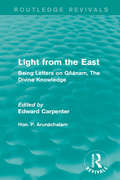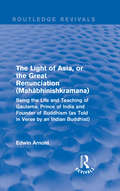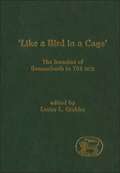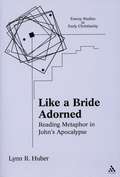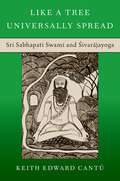- Table View
- List View
The Light Between Us: Lessons from Heaven That Teach Us to Live Better in the Here and Now
by Laura Lynne Jackson‘A marvellous book’ Dr Eben Alexander, author of Proof of Heaven‘She can pick up personal facts impossible to fathom by deduction or guesswork.” Jeanette Winterson, Sunday Telegraph‘We all have psychic experiences in our lives that connect us to one another and to those we love on the Other Side. Not just once in a while, but all the time.’Laura Lynne Jackson has been receiving communications from the afterlife since she was a child. In The Light Between Us she takes us through her struggle to come to peace with her gift and use it to help others. Through her moving and uplifting stories of the people she has helped, Laura Lynne shares her knowledge of how to understand these messages of love, and how we can use those lessons to help us live more peacefully in the present.
Light Force: A Stirring Account Of The Church Caught In The Middle East Crossfire
by Brother Andrew Al JanssenWhen the phenomenal success of GOD'S SMUGGLER made it too dangerous for his contacts in the underground church, Brother Andrew decided he could not return to Eastern Europe. He quietly turned his attention the the Middle East, and for the last thirty-five years he has been serving the Christian Church there, as well as witnessing to Jews and Muslims. His impassioned message is that there is a radical Christian approach to the stalemate of Middle East conflict. Only the gospel of love has the answer, and Christians are called to allow God to use them to demonstrate the example of Jesus. Now available with a fantastic new look to coincide with the B format edition of Brother Andrew's bestselling SECRET BELIEVERS, LIGHT FORCE brings Brother Andrew's story right up to date. It is every bit as exciting as GOD'S SMUGGLER, as Andrew has put his life on the line time and again in God's service.
Light from the Ancient Past, Vol. 1: The Archaeological Background of the Hebrew-Christian Religion
by Jack FineganA photograph, map, or diagram illustrates the text for every site described in this pilgrimage to Palestine, beginning with places connected with John the Baptist and proceeding to Bethlehem and Nazareth, Samaria and Galilee, Jerash, Caesarea, Jericho, the Mount of Olives, Jerusalem, and Emmaus. Each entry concludes with a brief bibliography of pertinent literature. Professor Finegan's knowledge of Christian theology and history plus his command of the archeology and topography of the Holy Land make his book an authoritative guide, a book for study and reference, and a volume for devotional reading.Originally published in 1969.The Princeton Legacy Library uses the latest print-on-demand technology to again make available previously out-of-print books from the distinguished backlist of Princeton University Press. These editions preserve the original texts of these important books while presenting them in durable paperback and hardcover editions. The goal of the Princeton Legacy Library is to vastly increase access to the rich scholarly heritage found in the thousands of books published by Princeton University Press since its founding in 1905.
Light from the Ancient Past, Vol. 2: The Archaeological Background of the Hebrew-Christian Religion
by Jack FineganA photograph, map, or diagram illustrates the text for every site described in this pilgrimage to Palestine, beginning with places connected with John the Baptist and proceeding to Bethlehem and Nazareth, Samaria and Galilee, Jerash, Caesarea, Jericho, the Mount of Olives, Jerusalem, and Emmaus. Each entry concludes with a brief bibliography of pertinent literature. Professor Finegan's knowledge of Christian theology and history plus his command of the archeology and topography of the Holy Land make his book an authoritative guide, a book for study and reference, and a volume for devotional reading.Originally published in 1969.The Princeton Legacy Library uses the latest print-on-demand technology to again make available previously out-of-print books from the distinguished backlist of Princeton University Press. These editions preserve the original texts of these important books while presenting them in durable paperback and hardcover editions. The goal of the Princeton Legacy Library is to vastly increase access to the rich scholarly heritage found in the thousands of books published by Princeton University Press since its founding in 1905.
Light from the East: Being Letters on Gñanam, The Divine Knowledge (Routledge Revivals: The Collected Works of Edward Carpenter)
by Hon. P. ArunáchalamLight from the East collates letters between Hon. P. Arunáchalam of the legislative council of Ceylon and Edward Carpenter, which expand on issues of the Gñanam or divine knowledge. Carpenter edited these letters for publication in 1927 as well as writing additional articles on issues such as desire, birth control and bisexuality in relation to the customs of Ceylon and religious laws of Hinduism to give the reader a broad insight into the religion. This title will be of interest to students of sociology, anthropology and religious studies.
Light from the East: Being Letters on Gñanam, The Divine Knowledge (Routledge Revivals: The Collected Works of Edward Carpenter)
by Hon. P. ArunáchalamLight from the East collates letters between Hon. P. Arunáchalam of the legislative council of Ceylon and Edward Carpenter, which expand on issues of the Gñanam or divine knowledge. Carpenter edited these letters for publication in 1927 as well as writing additional articles on issues such as desire, birth control and bisexuality in relation to the customs of Ceylon and religious laws of Hinduism to give the reader a broad insight into the religion. This title will be of interest to students of sociology, anthropology and religious studies.
Light from the East: Authors and Themes in Orthodox Theology
by Aidan Nichols OpNichols identifies a number of dogmatic issues, problems or ideas raised or discussed by Eastern Orthodox theologians. But issues of equal importance to Catholic theology as well.
Light in a Spotless Mirror: Reflections on Wisdom Traditions in Judaism and Early Christianity (Faith and Scholarship Colloquies)
by James H. Charlesworth Michael A. DaiseAfter the death of Alexander the Great in 323 B.C.E., Jewish scholars, especially those in Jerusalem and Alexandria, turned increasingly to the eternal questions that define those who reflect on human life. These sages sought to comprehend the origin and essence of things and pondered how it was possible to learn and obtain insight. Wisdom, they came to see, was the "fashioner of all things" who disclosed "what is secret and what is manifest." Many of these Jewish intellectuals saw Wisdom as the closest being to God.In this book, five of the world's foremost scholars in the field reflect on the Wisdom traditions in Second Temple Judaism and earliest Christianity. Roland Murphy (late of Duke University) explores the biblical and Jewish wisdom literature, and focuses on ways that Jews sought to understand sin and suffering.Peter Schäfer (Princeton University) argues that the association of Wisdom, Torah, and Israel found in biblical literature was taken up much later in the writings of the Rabbinic sages.Peder Borgen (formerly University of Trondheim, Norway) examines the similarities in the writings of the Hellenistic Jewish Wisdom teacher Philo of Alexandria and the writer of the Gospel of John.D. Moody Smith (Duke University) focuses on the Passion narrative in the Gospel of John as he demonstrates how much John relies on Jewish Wisdom tradition in his gospel. James Charlesworth (PrincetonTheological Seminary) examines the Wisdom aspects of some Jewish apocalypses in order to demonstrate that the Gospel of John draws upon both the Jewish Wisdom literature and Jewish apocalypses. James H. Charlesworth is George L. Collord Professor of New Testament Language and Literature at Princeton Theological Seminary, director of the seminary's Dead Sea Scrolls Project, and co-editor of the Trinity Press Faith and Scholarship Colloquies (FSC) series.Michael A. Daise is Assistant Professor of Religion at The College of William and Mary and has published articles on the Old Testament Pseudepigrapha and the Dead Sea Scrolls.
The Light of Asia, or the Great Renunciation: Being the Life and Teaching of Gautama, Prince of India and Founder of Buddhism (as Told in Verse by an Indian Buddhist) (Routledge Revivals)
by Edwin ArnoldThis study presents details about the life and philosophy of the founder of Buddhism, Prince Gautama of India or the Buddha, in the form of a poem as told from an imaginary Buddhist character. When originally published in 1926, little was known of Buddhism in Europe and Arnold aimed to inform the west of basic Buddhist concepts and the effects this had on India and Hinduism. This title will be of interest to students of Religion and Asian studies.
The Light of Asia, or the Great Renunciation: Being the Life and Teaching of Gautama, Prince of India and Founder of Buddhism (as Told in Verse by an Indian Buddhist) (Routledge Revivals)
by Edwin ArnoldThis study presents details about the life and philosophy of the founder of Buddhism, Prince Gautama of India or the Buddha, in the form of a poem as told from an imaginary Buddhist character. When originally published in 1926, little was known of Buddhism in Europe and Arnold aimed to inform the west of basic Buddhist concepts and the effects this had on India and Hinduism. This title will be of interest to students of Religion and Asian studies.
The Light of Learning: Hasidism in Poland on the Eve of the Holocaust
by Glenn DynnerThe Light of Learning tells the story of an unexpected Hasidic revival in Poland on the eve of the Holocaust. In the aftermath of World War I, the Jewish mystical movement appeared to be in shambles. Hasidic leaders had dispersed, Hasidic courts lay in ruins, and the youth seemed swept up in secularist trends as a result of mandatory public schooling and new Jewish movements like Zionism and Socialism. Author Glenn Dynner shows that in response to this, Hasidic leaders reinvented themselves as educators devoted to rescuing the youth by means of thriving networks of heders (primary schools), Bais Yaakov schools for girls and women, and world-renowned yeshivas. During the ensuing pedagogical revolution, Hasidic yeshivas soon overshadowed courts, and Hasidic leaders became known more for scholarship than miracle-working. By mobilizing Torah study, Hasidic leaders were able to subvert the "civilizing" projects of the Polish state, successfully rival Zionists and Socialists, and create clandestine yeshiva bunkers in ghettos during the Holocaust. Torah study was thus not only a spiritual-intellectual endeavor but a political practice that fueled a formidable culture of resistance. The Light of Learning belies notions of late Hasidic decadence and decline and transforms our understanding of Polish Jewry during its final hour.
The Light of Learning: Hasidism in Poland on the Eve of the Holocaust
by Glenn DynnerThe Light of Learning tells the story of an unexpected Hasidic revival in Poland on the eve of the Holocaust. In the aftermath of World War I, the Jewish mystical movement appeared to be in shambles. Hasidic leaders had dispersed, Hasidic courts lay in ruins, and the youth seemed swept up in secularist trends as a result of mandatory public schooling and new Jewish movements like Zionism and Socialism. Author Glenn Dynner shows that in response to this, Hasidic leaders reinvented themselves as educators devoted to rescuing the youth by means of thriving networks of heders (primary schools), Bais Yaakov schools for girls and women, and world-renowned yeshivas. During the ensuing pedagogical revolution, Hasidic yeshivas soon overshadowed courts, and Hasidic leaders became known more for scholarship than miracle-working. By mobilizing Torah study, Hasidic leaders were able to subvert the "civilizing" projects of the Polish state, successfully rival Zionists and Socialists, and create clandestine yeshiva bunkers in ghettos during the Holocaust. Torah study was thus not only a spiritual-intellectual endeavor but a political practice that fueled a formidable culture of resistance. The Light of Learning belies notions of late Hasidic decadence and decline and transforms our understanding of Polish Jewry during its final hour.
The Light of the Eyes: Homilies on the Torah (Stanford Studies in Jewish Mysticism)
by Rabbi Menachem GreenHasidism is an influential spiritual revival movement within Judaism that began in the eighteenth century and continues to thrive today. One of the great classics of early Hasidism, The Light of the Eyes is a collection of homilies on the Torah, reading the entire Five Books of Moses as a guide to spiritual awareness and cultivation of the inner life. This is the first English translation of any major work from Hasidism's earliest and most creative period. Arthur Green's introduction and annotations survey the history of Hasidism and outline the essential religious and moral teachings of this mystical movement. The Light of the Eyes, by Rabbi Menahem Nahum of Chernobyl, offers insights that remain as fresh and relevant for the contemporary reader as they were when first published in 1798.
Light of Zen in the West: Incorporating 'The Supreme Doctrine' and 'The Realization of the Self'
by Graham RoothThis Centenary Commemorative Edition also includes two lesser known works Buddha and the Intuition of the Universal and Techniques of Timeless Realization. The volume is complemented by a detailed Glossary, an Index, an Original Foreword by Aldous Huxley (1955), an Original Preface by Swami Siddheswarananda (1955), and a Contemporary Foreword by Professor Asanga Tilakaratne. Benoits writings on the human predicament and the path to inner freedom were influenced by his studies in Zen Buddhism and psychoanalysis. There is, as well, an evident dialogue in Benoits writings between the Gurdjieff teaching and Zen, with insightful ideas about universal laws, inner work, the human machine, and work in life. The Supreme Doctrine and The Realization of the Self foreshadow contemporary transpersonal and integral psychology: through the re-integration of psychology and metaphysics, Benoit invites us to make our own journey toward spiritual transformation and the intuitive understanding of universal truths. This Centenary Commemorative Edition also includes two lesser known works Buddha and the Intuition of the Universal and Techniques of Timeless Realization. The volume is complemented by a detailed Glossary, an Index, an Original Foreword by Aldous Huxley (1955), an Original Preface by Swami Siddheswarananda (1955), and a Contemporary Foreword by Professor Asanga Tilakaratne.
Light of Zen in the West: Incorporating 'The Supreme Doctrine' and 'The Realization of the Self'
by Graham RoothThis Centenary Commemorative Edition also includes two lesser known works Buddha and the Intuition of the Universal and Techniques of Timeless Realization. The volume is complemented by a detailed Glossary, an Index, an Original Foreword by Aldous Huxley (1955), an Original Preface by Swami Siddheswarananda (1955), and a Contemporary Foreword by Professor Asanga Tilakaratne. Benoits writings on the human predicament and the path to inner freedom were influenced by his studies in Zen Buddhism and psychoanalysis. There is, as well, an evident dialogue in Benoits writings between the Gurdjieff teaching and Zen, with insightful ideas about universal laws, inner work, the human machine, and work in life. The Supreme Doctrine and The Realization of the Self foreshadow contemporary transpersonal and integral psychology: through the re-integration of psychology and metaphysics, Benoit invites us to make our own journey toward spiritual transformation and the intuitive understanding of universal truths. This Centenary Commemorative Edition also includes two lesser known works Buddha and the Intuition of the Universal and Techniques of Timeless Realization. The volume is complemented by a detailed Glossary, an Index, an Original Foreword by Aldous Huxley (1955), an Original Preface by Swami Siddheswarananda (1955), and a Contemporary Foreword by Professor Asanga Tilakaratne.
Light Through the Crack: The Meaning of Life in the Face of Adversity
by Avi SagiAn epidemic such as COVID-19 challenges life’s very order and meaning, interferes in our relations with others, and breaks apart our routine. It raises many questions in the realms of ethics, politics, theology, psychology, and beyond. Perhaps more than anything else, it prompts us to ponder: what does this encounter with widespread anguish and distress imply about the human self-perception as sovereign rulers of Earthly life?In this book, renowned thinker Avi Sagi explores the existential matters brought to the philosophical fore by the pandemic. He shows how we, when thrown into the terror of a crisis, carry the traditions, values, ideals, hopes, failures, and habits that constitute our lives, all shaping the way we grapple with questions seemingly resolved. We may then find that the crack that opens up at times of sorrow can also be a moment of discovery. Sagi analyzes various ways of confronting the crack now at the heart of our existence. What emerges is a clear normative statement: We are not only what we were but also what we can be, and we can create a world of meaning by standing together with others.
Lighting the Path: The Dalai Lama teaches on wisdom and compassion
by The Dalai LamaIn this accessible and important follow up to The Art of Happiness His Holiness the Dalai Lama teaches us how to live a happier and more spiritual life by fostering compassion and wisdom.Filled with his trademark honesty and warmth, this book explains how practically applying the values of Buddhism can help you find answers to both the everyday problems we face - relationships, health, work and happiness - and the major issues and changes facing humanity today including globalisation, technology and terrorism.Drawn from the Dalai Lama's teachings during his fourth visit to Australia and New Zealand, which focused on gaining strength through compassion, Lighting the Path reminds us that we each have the ability to change our own life for the better, and the power to improve the lives of others as well.Explaining the central tenets of Buddhism, including the Four Noble Truths, Atisha's Lamp for the Path of Enlightenment and the Eight Verses of Mind Training, this book will give you the practical guidance you need to deal with life's challenges and help you develop inner peace.
Like a Bird in a Cage: The Invasion of Sennacherib in 701 BCE (The Library of Hebrew Bible/Old Testament Studies)
by Lester L. GrabbeWhat makes one crime more serious than another, and why? This book investigates the problem of "seriousness of offence" in English law from the comparative perspective of biblical law. Burnside takes a semiotic approach to show how biblical conceptions of seriousness are synthesised and communicated through various descriptive and performative registers. Seven case studies show that biblical law discriminates between the seriousness of different offences and between the relative seriousness of the same offence when committed by different people or when performed in different ways. Recurring elements include location and the offender's social statue. The closing chapter considers some of the implications for the current debate about crime and punishment.
Like a Bride Adorned: Reading Metaphor in John's Apocalypse (Emory Studies in Early Christianity)
by Lynn R. HuberThe phrase "like a bride adorned" is one of the ways Revelation describes the new Jerusalem which descends from heaven. This phrase can also be read as describing one of the ways interpreters historically have understood the relationship between Revelation and its metaphorical language. In contrast to views that suggest Revelation's metaphorical language is simple adornment, Huber argues that Revelation's persuasive power resides within the text's metaphorical nature and she articulates a method for exploring how Revelation employs metaphor to shape an audience's thought. In order to gain a sense of how metaphorical language works in Revelation's highly metaphorical text,"Like a Bride Adorned:" Reading Metaphor in John's Apocalypse engages one set of conceptual metaphors in relation to Revelation's literary and social-historical milieu. Specifically, Huber explores the conceptual metaphors undergirding Revelation's nuptial or bridal imagery. Positioned at the culmination of the text's, nuptial imagery serves as one the text's final and arguably one of its most important characterizations of the Christian community.Examining the function of Revelation's nuptial imagery involves investigating how the text redeploys conventional metaphorical constructions used in the writings of the Hebrew prophets and how its imagery engages Greco-Roman depictions of women, weddings, and brides. Discourse about marriage and family was such an important part of Revelation's historical context, especially as it was shaped by the Roman Empire, that any discussion of the text's nuptial imagery must examine how it reflects and responds to this discourse. By addressing these questions, we see that Revelation's nuptial imagery serves to further the text's goal of shaping Christian identity in opposition to the social demands of the Roman Empire. Moreover, exploration of the conceptual metaphors undergirding Revelation's "bride adorned" reveals how John seeks to shape Christian identity as a transitional identity. Through metaphor, Revelation encourages its audience to envision the Christian community as a bride who constructs "her" own identity as she transitions into a new role in relation to God and the Lamb. Through the process of exploring Revelation's nuptial imagery with insights gained from conceptual metaphor theory, we uncover the ways that John employs metaphorical language to persuade his audience's thought about themselves and about others. Consequently, this work contributes both to our understanding of the text's nuptial imagery and to our knowledge of how Revelation employs metaphor as tool for persuasion.
Like a Tramp, Like A Pilgrim: On Foot, Across Europe to Rome
by Harry BucknallWatching in disbelief as his computer was struck by lightning in 2007, Harry Bucknall had no idea that the subsequent trail of events would lead him to Rome – five years later, on foot.Following the Via Francigena, the ancient pilgrim path that dates back nearly two thousand years, Harry walks through England,France, Switzerland and Italy weaving a historical tapestry liberally coloured with tales of angels and saints, emperors and kings and war and revolution. He uncovers a little known route that leads him through vineyards and villages, towns and cities and over rivers and mountains to the heart of the Eternal City, Saint Peter's Basilica.Like A Tramp, Like A Pilgrim is a joyous journey of Elizabethan proportion filled with anecdote, adventure and mishap as Harry encounters the changing faces of a landscape suffused with history; yet his journey is perhaps most enriched by the extraordinary stories of those he meets - fellow pilgrims and locals alike - along the way.
Like a Tramp, Like A Pilgrim: On Foot, Across Europe to Rome
by Harry BucknallWatching in disbelief as his computer was struck by lightning in 2007, Harry Bucknall had no idea that the subsequent trail of events would lead him to Rome – five years later, on foot.Following the Via Francigena, the ancient pilgrim path that dates back nearly two thousand years, Harry walks through England,France, Switzerland and Italy weaving a historical tapestry liberally coloured with tales of angels and saints, emperors and kings and war and revolution. He uncovers a little known route that leads him through vineyards and villages, towns and cities and over rivers and mountains to the heart of the Eternal City, Saint Peter's Basilica.Like A Tramp, Like A Pilgrim is a joyous journey of Elizabethan proportion filled with anecdote, adventure and mishap as Harry encounters the changing faces of a landscape suffused with history; yet his journey is perhaps most enriched by the extraordinary stories of those he meets - fellow pilgrims and locals alike - along the way.
Like a Tree Universally Spread: Sri Sabhapati Swami and Śivarājayoga (OXFORD STU WESTERN ESOTERICISM SERIES)
by Keith Edward CantúThis book examines the life of a nineteenth- to early twentieth-century Tamil yogin named Sri Sabhapati Swami (Śrī Sabhāpati Svāmī or Capāpati Cuvāmikaḷ, ca. 1828-1923/4) and his unique English, Tamil, Hindi, and Bengali literature on a Sanskrit-based system of yogic meditation known as the "Rājayoga for Śiva" (Tamil: civarājayōkam, Sanskrit: śivarājayoga), the full experience of which is compared to being like a "tree universally spread." Its practice was based on a unique synthesis of Tamil Vīraśaiva and Siddhar cosmologies in the colonial period, and the yogic literature in which it is found was designed to have universal appeal across boundaries of caste, gender, and sectarian affiliation. His works, all of which are here analyzed together for the first time, are an important record in the history of yoga, print culture, and art history due to his vividly-illustrated and numbered diagrams on the yogic body with its subtle physiology. This book opens with a biographical account of Sabhapati, his editor Shrish Chandra Basu, and his students as gleaned from textual sources and the author's ethnographic field work. Sabhapati's literature in various languages is then analyzed, followed by a comprehensive exposition of his Śaiva cosmology and religious theories. Sabhapati's system of Śivarājayoga and its subtle physiology is then treated in detail, followed by an analysis of Sabhapati's aesthetic integration of aural sound and visual diagrams and an evaluation of the role of "science" in the swami's literature. Sabhapati also appealed to global authors and occultists outside of South Asia, so special attention is additionally given to his encounter with the founders of the Theosophical Society and the integration of his techniques into the thelemic "Magick" of Aleister Crowley, the German translation of Bavarian theosophical novelist Franz Hartmann, and the American publication of New Thought entrepreneur William Estep. To these are appended a never-before-translated Tamil hagiography of Sabhapati's life, a lexicon in table-form that compiles some archaic variants and Roman transliterations of technical terms used in his work, and a critically-edited passage on an innovative technique of Śivarājayoga that included visualizing the yogic central channel as a lithic "pole."




